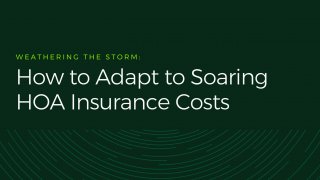- August 24, 2023
- CINC Systems

Our 2023 State of the Industry survey revealed that underfunded reserves are a leading concern among community association managers. Between recent high-profile events such as the 2021 Surfside Condo collapse, the increasing threat of natural disasters, and inflation driving up the cost of repairs, it’s hardly a surprise that underfunded reserves — once commonly dismissed as a routine budgetary concern — would be top of mind for association management professionals today.
What might be somewhat surprising is another trend driving up costs and depleting reserves: A dramatic increase in legal claims filed against homeowner associations.
“We are seeing an uptick in litigation,” said Sandra Gottlieb, an attorney specializing in community association law. “We’re seeing a lot of discrimination cases.”
Rises in such litigation tend to track with the economy, with far more claims filed during economic downturns. Insurance providers have reacted swiftly to the “perfect storm” of increased natural disasters and lawsuits.
Not only have premiums skyrocketed, escalating the financial burden on community associations and homeowners. Some insurers, such as State Farm, are issuing non-renewals to homeowners associations deemed risky. In fact, out of every ten carriers that may have issued proposals eight years ago, only about two now offer quotes, driving costs even further upward.
With so many pressing challenges to contend with, many HOAs are deprioritizing maintenance and reserves. But when reserves are too low, a single claim can bankrupt an association. In the short term, homeowner associations and management companies must be proactive in minimizing common mistakes that result in claims. In the long term, they can be part of the solution by actively fostering inclusive communities.
First, it helps to understand how we got here.
Understanding the Surge in Claims
According to Gottlieb, most claims against HOAs are related to injury or discrimination. On what grounds can someone sue an association for discrimination? The Fair Housing Act, initially passed in 1968, protects certain groups from discrimination when renting or buying a home, getting a mortgage, seeking housing assistance, or engaging in other housing-related activities. Widely regarded as the last great legislative accomplishment of the Civil Rights era, it has evolved to include more groups that face housing disparities; for example, in 2012, the law extended protected rights to the LGBTQ+ community.
Not all associations have updated their bylaws, language, or business practices accordingly. In fact, Racially-restrictive covenants still appear on the books in nearly every state in the U.S. A quick Google search would reveal multiple news reports about homeowners finding discriminatory or conflicting language in covenants and bylaws. In states like California, cases of hostility or discrimination are public record, which can inspire even more claims. That was the case for one community Gottleib encountered.
“I led a town hall saying they were killing themselves because the carriers will refuse to provide coverage,” she recalled.
HOAs don’t always realize they are violating laws around protected classes, but intentional or not, these mistakes can be extremely costly to associations.
Harnessing Technology for Change
The complex task of identifying and sanitizing bylaws and documents can be daunting. However, new AI technology offers a viable solution. Tools like the CINCit AI chatbot have the potential to scan and detect conflicting language based on the latest laws and statutes so community managers and board members can revisit the language.
Of course, no current technology can replace proper legal counsel. Gottlieb also recommends bringing in multiple perspectives when looking for potential problem areas.
“If management and legal walked around together, there would be red flags everywhere,” she said. “Prevention is important.”
It’s important to note that AI technology can also complicate things legally. Gottlieb has seen instances of people using AI to digitally alter evidence and documentation, such as security camera footage. And while AI can simplify routine tasks for community managers, such as writing violation letters, it can potentially introduce factual errors or even insensitive language. Having the right guardrails and security in place is critical.
Redefining the Narrative
In addition to the financial implications, the growing discrimination claims perpetuate the negative perception surrounding HOAs. However, we have an opportunity to reshape the narrative. By embracing new tools and solutions in the short term while working toward creating welcoming and inclusive neighborhoods for all, today’s community association management professionals can redefine what it means to live in a professionally managed community.
Related Reads

Blog
Unlocking Manager Potential: How Cephai in CINC Manager Frees Up Time for Engagement
- November 22, 2024

Blog
Keeping Calm and Carrying On: Leadership Tips for Turbulent Times
- November 20, 2024

Blog
AI at Bat: What Umpires, Baseball, and Data Security Can Teach Us About AI Risks
- October 28, 2024

Blog
Do I really need a homeowner app when I have a mobile-friendly website?
- October 14, 2024

Blog
Weathering the Storm: How to Adapt to Soaring HOA Insurance Costs
- October 1, 2024

Blog
How Today’s Generative AI Investment Drives Long-Term CAM Success: A Timeline
- September 16, 2024
